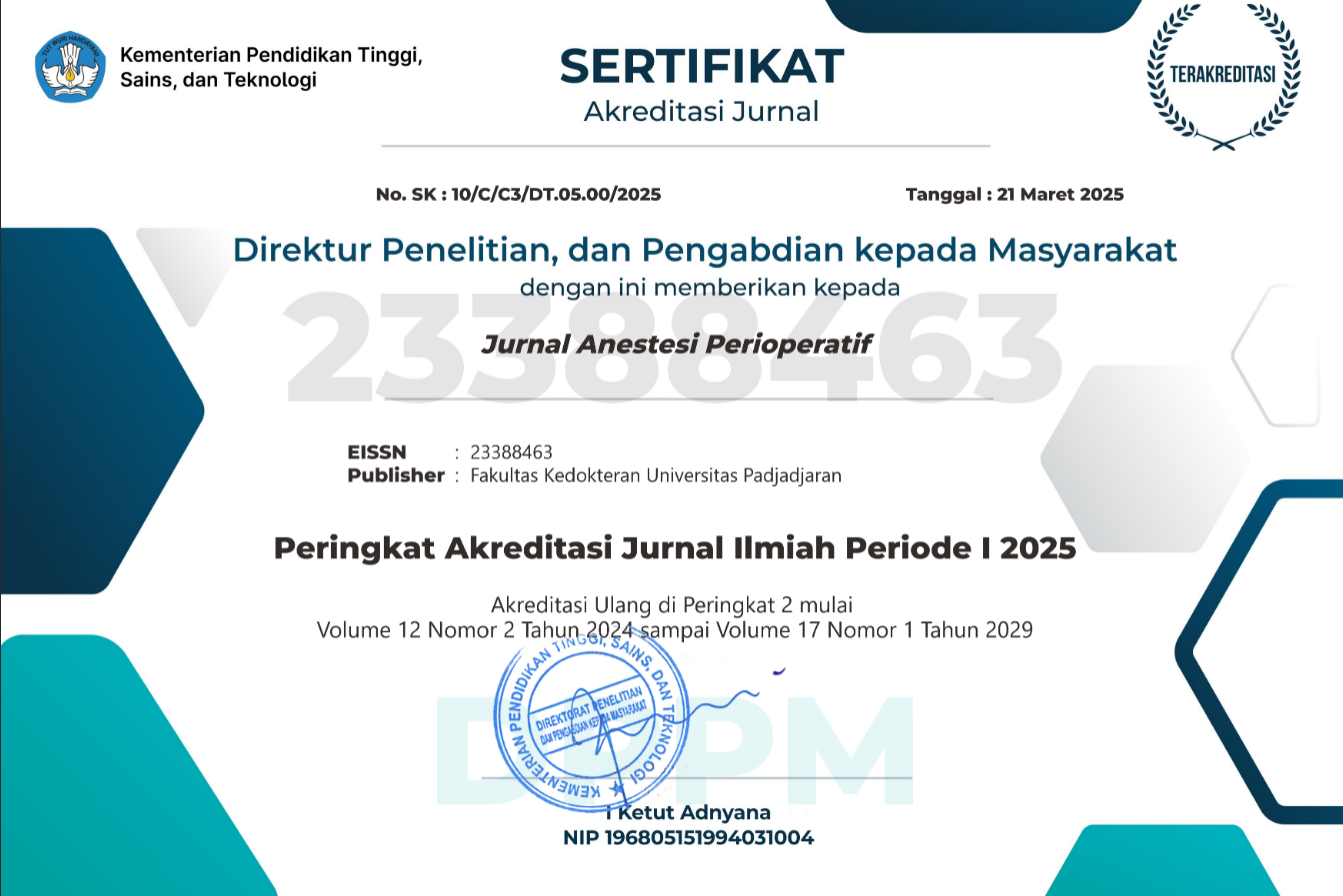Perbandingan Sevofluran dengan Propofol Target Controlled Infusion (TCI) sebagai Rumatan Anestesi terhadap Waktu pulih Sadar dan Komplikasi Mual Muntah pada Operasi Timpanoplasti
Abstract
Praktik anestesi membutuhkan kualitas anestesi yang baik, efek samping minimal, serta pemulihan cepat. Propofol dan sevofluran memiliki efek farmakologis pemulihan pascaanestesi yang cepat. Penelitian ini bertujuan mengetahui perbandingan sevofluran dengan propofol target controlled infusion (TCI) sebagai rumatan anestesi terhadap waktu pulih sadar dan komplikasi mual muntah pada operasi timpanoplasti. Penelitian dilakukan periode Agustus–November 2018 di RSUP Dr. Hasan Sadikin Bandung. Penelitian merupakan prospektif eksperimental menggunakan uji klinis acak buta tunggal terhadap 44 subjek yang dibagi acak menjadi dua kelompok, yaitu kelompok propofol TCI (kelompok P, n=22) dan kelompok sevofluran (kelompok S, n=22). Selama operasi dicatat lama operasi, jumlah opioid, waktu pulih sadar, dan komplikasi mual muntah. Analisis statistik data numerik dengan uji t tidak berpasangan dan Mann Whitney, data kategorik dengan uji chi square. Hasil penelitian tidak ada perbedaan signifikan (p>0,05) untuk karakteristik pasien, lama operasi, dan jumlah opioid perioperatif. Waktu pulih sadar kelompok sevofluran lebih cepat signifikan dibanding dengan propofol TCI (10,26±1,91 menit dan 13,36±1,72 menit; p<0,05). Komplikasi mual muntah pascaoperasi kelompok sevofluran lebih besar signifikan dibanding dengan propofol TCI (15 dan 1; p<0,05). Simpulan, sevofluran memiliki waktu pulih sadar lebih cepat dibanding dengan propofol TCI, namun komplikasi mual muntah sevofluran lebih besar.
Comparison between Effect of Sevoflurane with Propofol Target Controlled Infusion (TCI) as Maintenance of Anesthesia on Emergence Time and Nausea-Vomiting Complication in Timpanoplasty Surgery
Current modern anesthesia practice requires good anesthetic quality, minimum side effect, and early recovery. Propofol and sevoflurane have pharmacological properties that include fast recovery after anesthesia. The aim of this study was to evaluate the comparative effects of sevoflurane versus propofol target controlled infusion (TCI) for maintenance of anesthesia with respect to emergence time and postoperative nausea and vomiting (PONV) complication in patients undergoing timpanoplasty surgery. The study was carried out from August–November 2018 in Dr. Hasan Sadikin Bandung Hospital. It was a prospective single blind experimental study conducted on 44 subjects who were randomly divided to receive either propofol TCI (group P, n=22) or sevoflurane (group S, n=22). Duration of surgery, total ammount of opioid used, emergence time, and postoperative nausea and vomiting complication were recorded. Numerical data were tested by unpaired t test and Mann Whitney while categorical data were tested by chi-square. The results showed that patient characteristics, duration of surgery, and total amount of opioid used were not significantly different (p>0.05). Emergence time of the sevoflurane (S) group was significantly faster than the propofol (P) group (10.26+1.91 and 13.36+1.72, respectively; p<0.05). The complication of postoperative nausea and vomiting in group S was significantly higher compared to group P (15 and 1, respectively; p<0.05). It is concluded that sevoflurane has faster emergence time compared to propofol TCI, but PONV complication of sevoflurane is higher.
Keywords
Full Text:
PDFDOI: https://doi.org/10.15851/jap.v7n1.1620
Article Metrics
Abstract view : 1409 timesPDF - 740 times
This Journal indexed by

JAP is licensed under a Creative Commons Attribution-NonCommercial 4.0 International License
View My Stats



